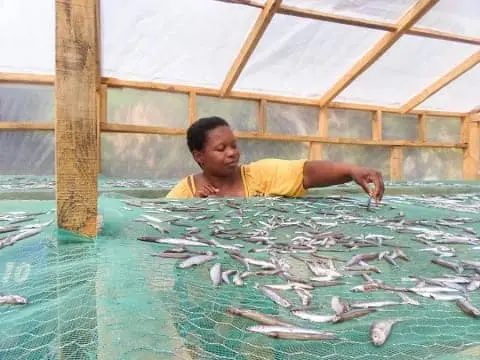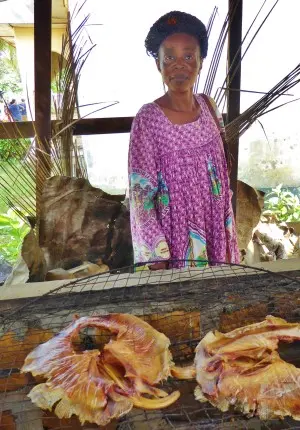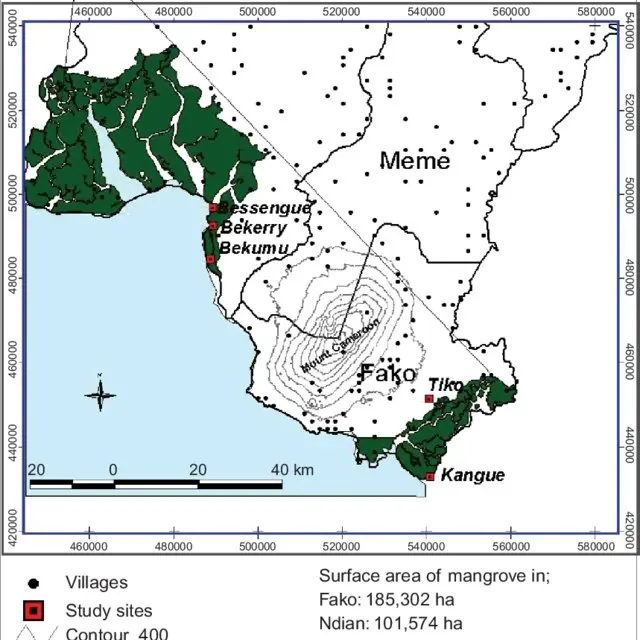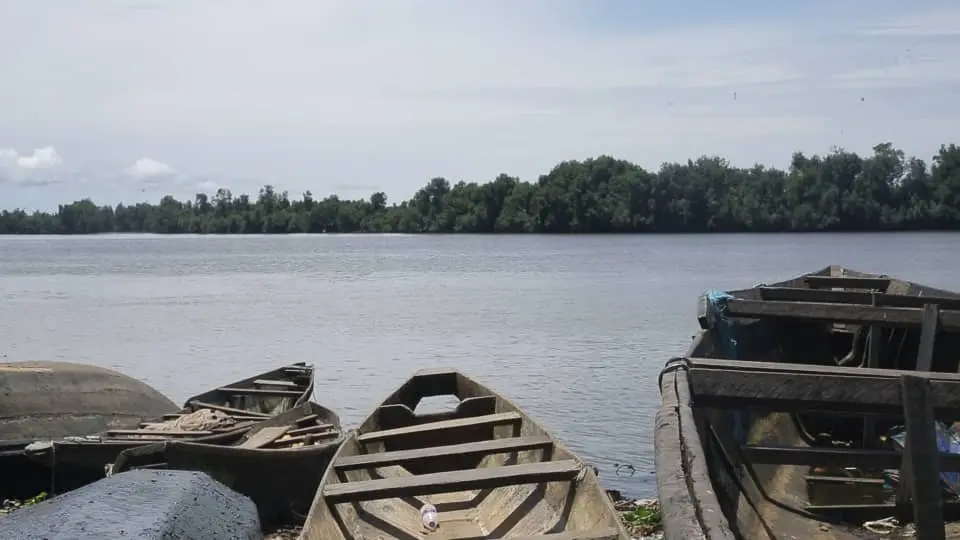
Renewable energy-powered ovens introduced in some fishing communities along the coastal regions of Limbe and Douala in Cameroon are helping the country redress the challenges of dwindling mangrove forests, mitigate the effects of climate change and fight poverty.
Local councils, NGOs and other stakeholders are backing government’s efforts to protect mangroves with the use of alternative energy other than fuel wood for cooking and drying fish by the local communities.
In the coastal towns of Batoke and Idenau, fish traders are doing brisk business thanks to the installation of solar-powered ovens to dry fish, preventing what used to be the massive destruction of swathes of mangrove forest for firewood and spoilage from a lack of other preservation methods.
Others have been using eco-friendly charcoal made from waste materials as well as fish scales as alternative energy for their fish smoking and cooking.
Fish smokers in these communities say the renewable energy project has improved on their awareness and knowledge about mangrove protection.
“We have come to learn about this new method that permits us dry our fish without much stress with the use of solar ovens and protect our forest,” says Joan Dione, a fish smoker in Idenau whose business is driven by customers from big cities in Cameroon and neighbouring Nigeria and Gabon.

The renewable energy-powered ovens provided for fish drying to replace wood along the coastal villages of Batoke and Idenau. Down beach in Limbe is a mangrove restoration programme supported by the Cameroon government, the Cameroon Wildlife Conservation Society, CWCS, Cameroon Mangrove and Wetlands Conservation Network, and the World Wide Fund for Nature (WWF), geared not only at giving life to the populace of the local community, but also to assuring the environmental future of generations not yet born, conservation experts say.
“Alternative energy has gone a long way to not only protect existing mangrove forest and restoring the rich biodiversity of the coastal areas, but also improve the livelihood of the community through quality and quantity fish catch,” says Timothy Kagonbe, sub-director in charge of local partnerships in the ministry of environment and Cameroon focal point in the Inter Governmental Group of Experts on Climate Change.
In 2018, Some 25 fishing groups in Idenau and nearby Batoke in the coastal region of Limbe were also offered solar energy fish-drying ovens by the African Resource Group Cameroon (ARG-CAM) working in collaboration with the Limbe city council as part of a wider drive to expand renewable energy like solar across the country.
The women attest the alternative fish drying methods have really improved their income.
Joan Dione’s daughter Sharon Dione, 23, says that in the past, drying a significant quantity of fish of 25 baskets in a day using wood was impossible.
“The process of using wood energy was so difficult, emitting smoke that was dangerous to our health and limited our production,” says Sharon Dione.
“The arrival of solar energy and solar drying ovens here has changed everything,” she adds.
The Limbe City Mayor, Paul Efome Lisombe Mbole, says the arrival of alternative energy for fish drying and cooking is a welcome relief to the development drive and environmental protection efforts in the coastal city, which is very vulnerable to the effects of climate change.
“The coming of alternative and cheaper energy to our council area is a welcome relief. The project was born out of the need to improve the livelihoods of the people, conserve, protect mangroves and fight against climate change. We are moving to a new world now,” Paul Efome said.
The Limbe City Council district is a coastal area beset with numerous challenges related to climate change and environmental degradation.
“Given the fragile nature of its ecosystem, it is imperative that all our activities, economic or otherwise, are carried out in a sustainable manner,” the mayor explained.

Douala Coastline
The same efforts have been carried out in the coastal and industrial city of Douala. At Youpwe, a popular fish market in Douala, Cameroon's economic capital, the women are always busy smoking fish. They have been using eco-friendly charcoal to smoke fish.
"It came to us as a surprise that what is considered waste can be used to produce charcoal to dry fish," Ngonno Lizette, 42 years old, noted.
Another fish smoker in Youpwe, Marie Louis Kuetche, says their overdependence on the mangrove to smoke fish was already having a counter effect on their business. "For several years, we depended solely on mangrove wood to dry fish. But later we began realizing fish was becoming scarce and from what we gathered this was as a result of the uncontrolled destruction of mangroves," she explained.
"This new form of charcoal from waste material is very clean, and fish dried from it looks bright and sells better in the market," Kuetche added.
The phenomenon is already gaining ground in different fishing communities as locals strive to protect their mangroves.
In Mouanko, in the Sanaga Maritime division of the Littoral Region, women are also switching to these eco-friendly forms of charcoal.
In a bid to also curb the pressure on fishing, a local NGO, Mounako Horrizon 2000, is helping locals diversify their income by involving them in agriculture as alternative source of income.
Same Diyouke, president of the NGO, explained how the drive for environmental sustainability led to the birth of converting trash into manure for agriculture. "We are happy this is turning the tides, as many of the women in the fish business are also taking interest in agriculture activities," he says. "For long we watched how our mangroves were being depleted to dry fish, we also saw those who did agriculture practice slash and burn, destroying the ecosystem. It was [for] the zeal to curb these unsustainable activities that we started transforming waste to organic fertilizer. Today, for the first time, rice is cultivated in Mouanko with the use of the compost manure we produced," he added.
Reports show that about 30% of Cameroonians living along the coastal areas of Limbe and Doaual depend on mangrove resources for their livelihoods, particularly fish, timber and non-timber forest products.
Government statistics estimate about 1% of mangroves are lost every year. The situation is even higher in the mangrove forests of the Wouri estuary in the industrial city of Douala, with some 6.2% destruction rate per year.
Environmental experts blame this on multiple factors like surging coastal population, urbanization, fish processing, sand extraction, an uncoordinated government and weak laws that are not always applied.
“The government needs to apply its laws by effectively sanctioning defaulters,” says Samuel Nguiffo, CEO of the Centre for Environment and Development, an NGO the fights for the rights of forest Indigenous communities in Cameroon.
Cameroon’s minister of environment and nature protection, Hele Pierre, noted during the launching of tree planting along the coastal area of Limbe on June 12, 2022, that protecting the country’s mangroves was part of government’s efforts to drive forest conservation in the species-rich Congo Basin, home to the world’s second-largest tropical rainforest.
“By restoring disappearing trees along the coast, we are helping local communities develop sustainably, fight poverty, increase their resilience to climate change and contribute to climate change mitigation,” Pierre said.
Tree planting along the Limbe, Wouri and Kribi Coast is a yearly mangrove restoration programme by the government supported by other stakeholders and especially with the active participation of the local communities.
“The yearly mangrove restoration efforts is a community affair because the villagers know their future lies in the coastline mangrove,” says Theophilus Ngwene, Programme Executant WWF Coastal Forest programme.
Humped over the soil, villagers and fishermen alike in Limbe, Mouanko and other fishing communities along the coast say they have been working feverishly, planting stalks of mangrove to replace the swathes destroyed by the population for firewood and building material as well as development projects
Fisherman Ongene Auswald says he has not missed a single mangrove planting session in the last three years. He says the mangrove restoration efforts are already paying off with improved fish catch.
“Since we started caring for the mangroves, we harvest more and more fish,” he says.
“Now, fishermen from as far off as Kribi come to fish on our shores,” Ongene adds.
Fishing has always been the way of life for the people of Mouanko, one of the villages off the shores of Wouri river in Cameroon’s economic capital.

Ebounge Ralph, 68, the chairman of the village fishing community, recalled the days of his childhood when fishers used traditional fishing methods to make a good catch just a few meters away from the village.
“But fishing soon become perilous following the vast destruction of the Wouri coastline's rich mangrove forest,” Ebonge reveals.
Environment expert have saluted the conservation efforts especially as it is geared towards reducing poverty and the degradation rates of Cameroon’s coastal mangroves, thereby contributing to strengthening the role of the country’s ecosystem in disaster risk reduction.
"The role of ecosystems in disaster risk management, especially in the coastal area, cannot be ignored. Ecosystems with strong tree cover reduce the vulnerability of the coastline to floods. Mangroves especially act as buffers that help to reduce the risk of erosion and inundation," says Timothy Kagonbe.
Experts say mangrove forests absorb three to four times more carbon than tropical upland forests. In addition, their complex root networks are known to serve as a buffer against strong waves, high winds and storms, thus preventing the degradation of coastal forest ecosystems.
“Mangroves are not only important to fishermen, acting as breeding ground of fish, but they are good carbon absorbers and an important source of income to the beneficiary communities,” says Samuel Nguiffo.
Mangroves make up less than 1% of tropical forests worldwide, but they are crucial in the fight against climate change because they are more effective than most other forests at absorbing and storing planet-heating carbon.
Environment experts salute the involvement of local communities in mangrove restoration efforts as they stand a better chance of protecting their resources.

“When local communities take ownership of the restoration programme, they jealously protect and guard the forest against intrusion from outsiders," says Cecil Ndjebet, member of the African Forest Forum (AFF) governing council.
Globally, mangroves are estimated to be declining at a rate of about 1-2% per year, with human activities contributing to an estimated 2.7 million hectares of lost forests every year on the African continent, Ndjebet says, calling on women to add their voices against any unsustainable exploitation.
“Women across the continent should add their voice to say no to wanton mangrove forest destruction,” Ndjebet said.
- View this story on Voice of Nature News
- View this story on Mimimefo Info
- View this story on Reporter 254
- View this story on EnviroNews Nigeria
- View this story on Cameroon News Agency
- View this story on PAMACC News Agency













